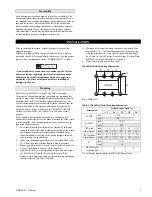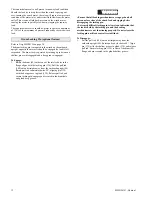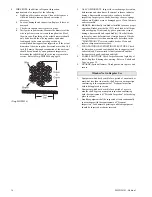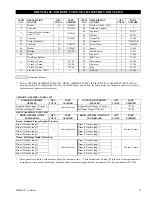
18
MHD56181 - Edition 1
TROUBLESHOOTING
This section provides basic troubleshooting information. Determination of specific causes to problems are best identified by thorough
inspections performed by personnel instructed in safety, operation and maintenance of this equipment. The chart below provides a brief guide
to common winch symptoms, probable causes and remedies.
SYMPTOM
CAUSE
REMEDY
Load continues to move
when winch is stopped.
Drum brake is slipping.
Check drum brake adjustment and brake band lining wear.
Winch is overloaded.
Reduce load to within rated capacity.
Control valve may not be correct type.
The correct control valve should have
all ports open to reservoir when the
spool is in the neutral position.
If the motor ports in the valve are blocked by the spool (closed center)
when the control valve is in the neutral position, remove valve and
replace with correct tandem center (A & B to tank) or float center
motor spool (P, A & B to tank) valve.
There is excessive back pressure
acting on the reverse port of the winch
motor and disc brake charge port.
Install pressure gauges in motor lines. Run the pump at its maximum
RPM and, with the control valve in the neutral position, read the
pressure gauges. Pressure greater than 140 psig (9.6 bar/9.8 kg/cm²) is
too high. Check hose and control valve size. Replace if necessary.
Winch does not lift or pull
load.
Motor may be damaged.
Remove and disassemble motor as recommended by the motor
manufacturer. Examine all parts and replace any that are worn or
damaged.
No oil supply to winch.
Check oil supply line connections and hoses.
Winch is overloaded.
Reduce load to within rated capacity.
Insufficient oil supply.
Verify oil supply pressure and volume at winch inlet meets the
specified requirements. Clean oil filter.
Motor variable displacement may be
set too low.
Adjust displacement to a higher setting. Refer to motor manufacturer’s
literature.
System not delivering full pressure to
winch.
Confirm pump is running and on stroke. Check upline flow controls are
set as required to run the winch.
Relief valve dumps full pressure.
Confirm no downline restrictions of valves are blocking free flow back
to tank.
Relief valve set too low.
Install pressure gauges in motor lines and apply a stall pull on the
winch. If pressure is low, increase relief valve setting until
recommended pressure is obtained.
Relief valve is partially open.
Remove relief valve and visually inspect and repair or replace worn or
damaged parts. Clean all parts thoroughly in a suitable solvent.
Reassemble, reinstall and reset relief valve pressure setting.
Oil level in reservoir too low. Suction
line may be restricted or have an air
leak causing cavitation at the inlet
pump. ‘Whining’ noise at pump is an
indication of this problem.
Check oil level in reservoir. Check suction line externally and
internally for damage. Replace suction line if damaged. If cavitation
has occurred, it is recommended that the pump be disassembled and
inspected for worn, pitted and damaged parts. Repair and replace parts
as necessary.
Control lever moves but
winch does not operate.
Motor may be damaged.
Remove and disassemble motor as recommended by the motor
manufacturer. Examine all parts and replace any that are worn or
damaged.
Insufficient oil supply.
Verify oil supply pressure and volume at winch inlet meets the
specified requirements. Clean oil filter.
Drum locking pin (optional feature) is
engaged.
Disengage drum locking pin.
Winch runs slow.
Improper hose or fitting sizes.
Check fittings, connections and hoses for correct size and length.
Replace parts that may cause restricted oil flow. Inspect oil filter.
Motor variable displacement set too
high.
Lower motor variable displacement setting. Refer to motor
manufacturer’s literature.
Motor may be damaged.
Remove and disassemble motor as recommended by motor
manufacturer. Examine all parts and replace any that are worn or
damaged.
Содержание Force 5 FH5
Страница 28: ...28 MHD56181 Edition 1 DRUM BRAKE ASSEMBLY PARTS Dwg MHP0153 ...
Страница 34: ...34 MHD56181 Edition 1 SERVICE NOTES ...
















































